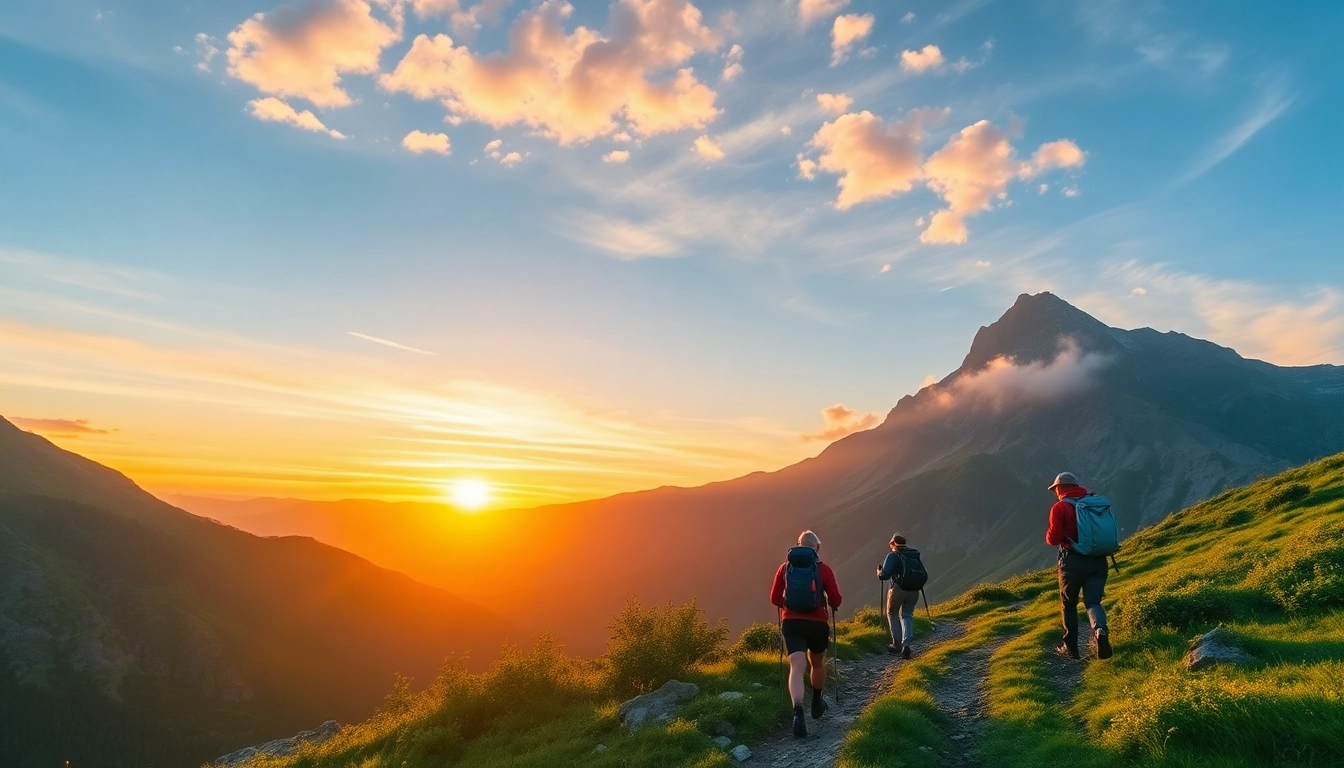Introduction to Hiking: Unlocking Nature’s Trails
In an era marked by rapid technological advancement and urbanization, the allure of nature remains a timeless sanctuary for physical, mental, and spiritual rejuvenation. Among outdoor activities, hike has surged in popularity due to its accessibility, health benefits, and unique opportunity to connect with the natural world. Whether traversing mountain trails, forest paths, or rugged terrains, hiking offers a holistic experience that combines exercise, adventure, and mindfulness. This comprehensive guide aims to delve deep into the essence of hiking, exploring its rich history, practical planning steps, essential gear, the best trails in Indonesia and beyond, and tips to maximize safety and enjoyment.
What Defines a Hike and Its Benefits
Defining a Hike
At its core, a hike is a sustained walk that takes place on trails or footpaths in natural environments, often extending over significant distances. Unlike casual strolls on flat, maintained surfaces like sidewalks or park pathways, hikes typically involve navigating diverse terrains, including steep inclines, rocky paths, forested areas, and mountain ascents. The hallmark of hiking is its focus on exploration, physical challenge, and immersive interaction with nature.
Physical and Mental Benefits
Engaging in regular hiking offers profound health advantages. Physically, it enhances cardiovascular fitness, strengthens muscles, improves flexibility, and aids weight management. According to a study published in the American Journal of Preventive Medicine, hikers burn an average of 430-480 calories per hour, depending on terrain and pace. Mentally, hiking reduces stress, alleviates symptoms of depression and anxiety, and boosts overall mood by releasing endorphins. Furthermore, being immersed in natural settings has been linked to improved concentration, creativity, and mental clarity, a phenomenon known as “nature therapy.”
Beyond individual health, hiking fosters social bonds and community engagement through group treks, conservation efforts, and outdoor clubs. It also instills a sense of environmental stewardship, encouraging hikers to practice eco-friendly principles, which we’ll explore further.
Historical Origins and Evolution of Hiking
Origins of Hiking
The practice of walking for pleasure and exploration dates back centuries, with roots in European aristocratic leisure during the 18th century. The term “hiking” itself gained prominence in Britain and Germany in the 19th century, evolving from leisurely walks in the countryside to organized outdoor activities. Early hikers often followed scenic routes, connecting rural villages and towns, fostering an appreciation for natural beauty.
Development Over Time
As transportation improved and the industrial revolution catalyzed urban growth, hiking grew into an organized recreational activity. The late 19th and early 20th centuries saw the rise of national parks and hiking clubs, such as the Appalachian Mountain Club in the United States and the British Ramblers Association. These organizations promoted conservation, mapped trails, and popularized hiking as a healthy lifestyle choice.
Hiking in Contemporary Culture
Today, hiking is a global phenomenon embraced by people of all ages and backgrounds. Advances in gear, digital navigation tools, and increased environmental awareness have enhanced the accessibility and experience of hiking. In Indonesia, regions like Lombok, Bali, and Java have developed renowned hiking trails, attracting international tourists and local enthusiasts alike. The activity now intertwines with ecotourism, adventure tourism, and wellness retreats, adapting to modern lifestyles.
Why More People Are Choosing Hiking Today
Health Consciousness and Wellness Trends
Increasing awareness about wellness and holistic health has made hiking a favored activity. It offers a low-cost yet effective way to maintain fitness without requiring specialized equipment or gym memberships. Additionally, the rise of social media has amplified exposure to breathtaking landscapes and inspiring hike stories, motivating more individuals to explore the outdoors.
Desire for Authentic Experiences
Modern travelers seek authentic, meaningful experiences, often reflecting a desire to escape urban chaos and reconnect with nature. Hiking provides an immersive environment where individuals can witness local flora and fauna, experience cultural exchanges, and develop a personal sense of achievement.
Environmental and Sustainable Tourism
With increased environmental consciousness, many hikers incorporate conservation efforts, adhering to Leave No Trace principles and supporting eco-tourism initiatives. Countries like Indonesia, rich in biodiversity and scenic landscapes, promote hiking as a sustainable activity that benefits local communities and preserves natural ecosystems.
Planning Your Perfect Hike: From Preparation to Execution
Choosing the Right Trail and Destination
Selecting an appropriate trail hinges on your fitness level, experience, environmental conditions, and personal interests. Beginners may prefer well-marked paths with minimal elevation gain, such as forest trails or coastal walks. Seasonality is crucial; dry seasons offer better trail conditions, while monsoon periods may pose risks of flooding or slippery surfaces. Research the trail’s length, difficulty, permits required, and local regulations. For instance, in Indonesia, popular hiking spots like Mount Rinjani in Lombok or Mount Batur in Bali offer varied experiences for different skill levels.
Essential Gear and Safety Equipment
Proper preparation includes investing in quality gear tailored to the terrain and climate. Essential items include sturdy hiking shoes, layered clothing for changing weather, navigation tools (compass, GPS device), hydration supplies, and a first aid kit. Additional safety gear like trekking poles, headlamps, and emergency signaling devices enhance preparedness. It’s vital to carry a detailed map or trail guide and to inform someone about your plans and expected return time.
Tips for Navigating & Enhancing Your Experience
Navigational proficiency is key; familiarize yourself with trail signs, landmarks, and digital maps. Respect local customs and wildlife, minimizing impact on ecosystems. Incorporate mindfulness practices—pause to observe flora, listen to natural sounds, and breathe consciously. Carry lightweight binoculars or cameras for capturing scenic vistas. Planning breaks and pacing yourself ensures sustained energy and enjoyment. Remember, preparation and adaptability are the pillars for a successful hike.
Hiking Gear & Accessories: Outfit for Success
Footwear: Hiking Shoes and Boots
Footwear is arguably the most critical gear component. The ideal hiking shoe provides adequate support, traction, waterproofing, and comfort. For rugged terrains, high-ankle hiking boots prevent ankle injuries and offer stability, whereas trail runners may suffice for less demanding paths. Regularly inspect and replace worn-out soles to prevent blisters and injuries.
Clothing and Layers for All Weather
Technical, moisture-wicking layers keep you dry and regulate body temperature. Base layers manage sweat, mid-layers provide insulation, and outer layers protect against wind and rain. Use lightweight, quick-drying fabrics, and pack an waterproof jacket or poncho. Sun protection gear such as hats, sunglasses, and sunscreen is equally vital.
Tech Gadgets and Safety Items
Modern hikers benefit from GPS watches, portable chargers, and emergency communication devices. Personal safety items can include whistles, pepper spray, and multi-tools. Incorporate trail apps for real-time updates, weather alerts, and route planning to enhance safety and logistical ease.
Popular Hiking Trails in Indonesia and Beyond
Top Trails in Bali, Lombok, and Java
- Mount Rinjani, Lombok: Indonesia’s second-highest volcano, offering challenging multi-day treks with stunning crater lake views.
- Mount Batur, Bali: An accessible sunrise hike, ideal for beginners; panoramic vistas of the caldera and Lake Batur await.
- Semeru, Java: Known as the “Great Mountain,” it presents technical trails with volcanic landscapes—best suited for experienced hikers.
International Destinations for Enthusiasts
- Inca Trail, Peru: A historic trek leading to Machu Picchu, blending culture and natural beauty.
- Torres del Paine, Chile: Patagonian wilderness with glaciers, mountain peaks, and diverse wildlife.
- Grand Canyon, USA: Spectacular vistas and challenging terrains appeal to adventurous hikers.
Factors to Consider When Selecting a Trail
When choosing a trail, evaluate difficulty level, distance, altitude gain, climate, and available facilities. Consider your fitness, experience, and goals—whether seeking a quick day hike or a prolonged expedition. Additionally, understand local regulations, permits, and conservation practices to ensure responsible enjoyment.
Maximizing Your Hiking Experience and Staying Safe
Preparing Physically and Mentally for Trekking
Prepare physically through regular cardiovascular training, strength conditioning, and flexibility exercises. Incorporate trail walking with similar elevation gains and terrain to simulate actual conditions. Mentally, cultivate resilience by setting realistic expectations, practicing mindfulness, and learning to adapt to unforeseen circumstances.
Leave No Trace Principles and Eco-Conservation
Protect the environment by following Leave No Trace (LNT) guidelines: plan ahead, dispose of waste properly, respect wildlife, stay on designated trails, and minimize campfire impact. Supporting local conservation projects and choosing eco-friendly gear further contribute to preserving natural landscapes.
Tracking Progress and Measuring Success
Use trail logs, GPS devices, or smartphone apps to monitor your routes, distances, and elevation gains. Celebrate milestones—completing a challenging ascent or witnessing a scenic sunrise. Reflecting on experiences fosters motivation, improves future planning, and deepens your appreciation for outdoor adventures.



